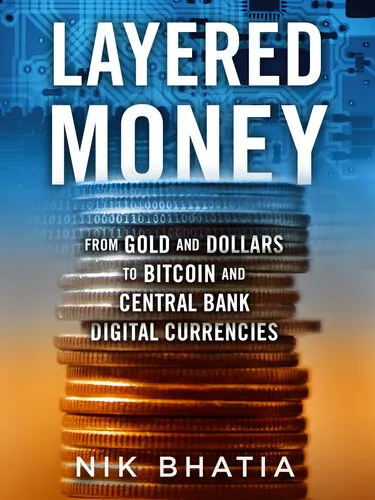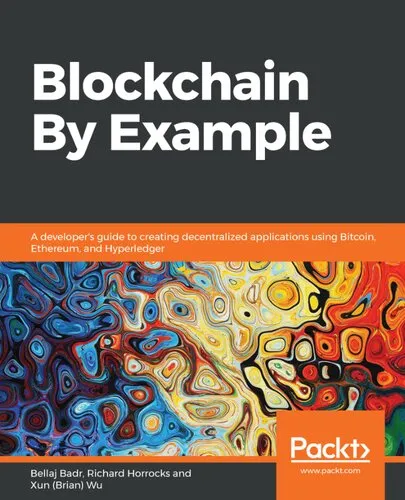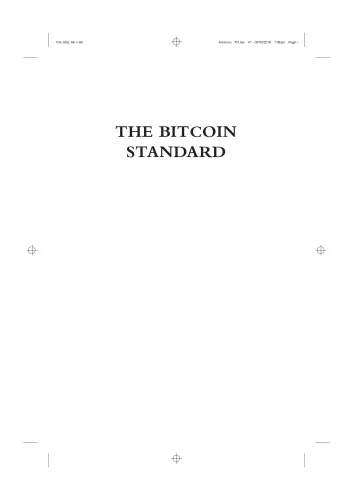Layered Money: From Gold and Dollars to Bitcoin and Central Bank Digital Currencies
4.5
Reviews from our users

You Can Ask your questions from this book's AI after Login
Each download or ask from book AI costs 2 points. To earn more free points, please visit the Points Guide Page and complete some valuable actions.Related Refrences:
Introduction to 'Layered Money: From Gold and Dollars to Bitcoin and Central Bank Digital Currencies'
Finance is the lifeblood of modern civilization, and at the core of all financial systems lies money—a layered construct that has evolved for centuries. In Layered Money: From Gold and Dollars to Bitcoin and Central Bank Digital Currencies, I aim to unravel the complex, layered history of money while charting its transformative journey from ancient gold systems to the decentralized power of Bitcoin and beyond. This book connects the dots in monetary history, bridging the gap between traditional finance and the digital revolution that is reshaping the global economy.
The concept of layering in money provides clarity on how the financial system is structured. By dissecting these layers, this book examines the relationships between individuals, institutions, governments, and now, decentralized technologies like Bitcoin. Through vivid storytelling and in-depth analysis, Layered Money takes the reader on a journey that begins with gold at the foundation of money, flows into the dominance of government-issued currencies like the US Dollar, and culminates in Bitcoin’s arrival as a decentralized alternative and the potential rise of Central Bank Digital Currencies (CBDCs).
A Detailed Summary of the Book
The book opens by discussing the origins of money, particularly how early civilizations relied upon commodities such as gold for trade and commerce. These physical commodities were the "first layer" of money, providing a fundamental base of trust and value. As society evolved, layers of abstraction were introduced. Governments began issuing paper currency as a "second layer" backed by gold reserves. Over time, with the abandonment of the gold standard, fiat currencies like the US Dollar became dominant, facilitated by financial institutions that added their own layers of credit and trust.
Bitcoin, introduced in 2009, adds a radically new layer to the architecture of money: decentralization. Unlike traditional fiat systems controlled by central authorities, Bitcoin operates independently of institutions, challenging the monopoly of state-controlled money. The book explores its core principles, such as scarcity, transparency, and immutability, which differentiate it from previous monetary layers.
Finally, the book examines the next frontier—Central Bank Digital Currencies (CBDCs). As governments and central banks develop their own digital currencies in response to Bitcoin's growing popularity, the global financial system is entering uncharted territory. While CBDCs promise convenience and efficiency, they also raise questions about surveillance, privacy, and the risks of centralization.
This evolutionary perspective helps readers better understand the forces shaping the past, present, and future of money.
Key Takeaways
- The Concept of Monetary Layers: Money is structured in layers, from the physical base of gold to the digital abstraction of today’s cryptocurrencies.
- The Role of Bitcoin: Bitcoin stands as a third-layer innovation in the history of money, offering a decentralized and scarce alternative to fiat currencies.
- The Implications of CBDCs: Central Bank Digital Currencies represent the next step in monetary evolution but come with centralization risks and privacy concerns.
- The Journey of Trust: The history of money is also the history of trust, beginning with commodities and now being tested by decentralized and algorithm-driven systems.
- A Call for Awareness: In a rapidly advancing financial landscape, understanding money’s layered structure helps individuals and institutions prepare for what's next.
Famous Quotes from the Book
- “Bitcoin is not just digital money; it represents a new layer in the history of money itself.”
- “Trust is the most fundamental requirement of any monetary system. Bitcoin removes the need for trust in intermediaries.”
- “Central Bank Digital Currencies are both fascinating and frightening. They offer modernization but risk unprecedented surveillance.”
- “The transition from gold to fiat was not the end of money's evolution—it was a stepping stone.”
Why This Book Matters
This book serves as an essential guide for anyone eager to understand the massive shifts reshaping global finance. As innovations like Bitcoin and CBDCs challenge traditional monetary systems, understanding the layers of money equips readers with the knowledge to adapt and thrive in the digital economy. Whether you are an investor, policymaker, or curious learner, the concepts outlined in this book provide a framework for navigating an uncertain financial future.
The book is especially timely as debates about financial inclusion, privacy, and centralization dominate global discussions. By explaining the layered structure of money, it fosters a deeper understanding of how trust, value, and technology interact in shaping the future of our financial systems.
Free Direct Download
You Can Download this book after Login
Accessing books through legal platforms and public libraries not only supports the rights of authors and publishers but also contributes to the sustainability of reading culture. Before downloading, please take a moment to consider these options.
Find this book on other platforms:
WorldCat helps you find books in libraries worldwide.
See ratings, reviews, and discussions on Goodreads.
Find and buy rare or used books on AbeBooks.
1277
بازدید4.5
امتیاز0
نظر98%
رضایتReviews:
4.5
Based on 0 users review
Questions & Answers
Ask questions about this book or help others by answering
No questions yet. Be the first to ask!













